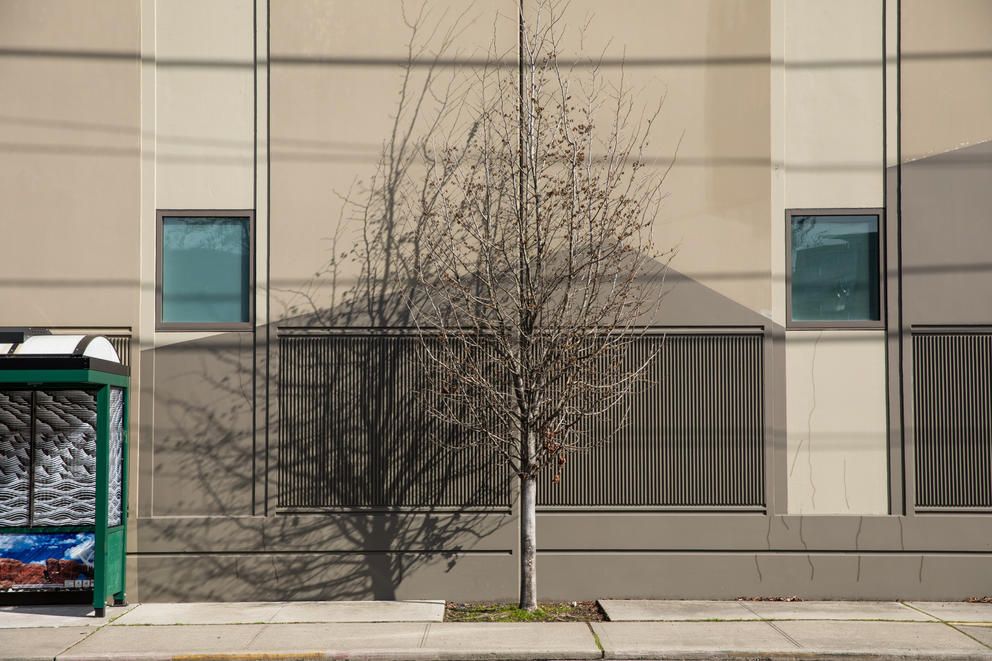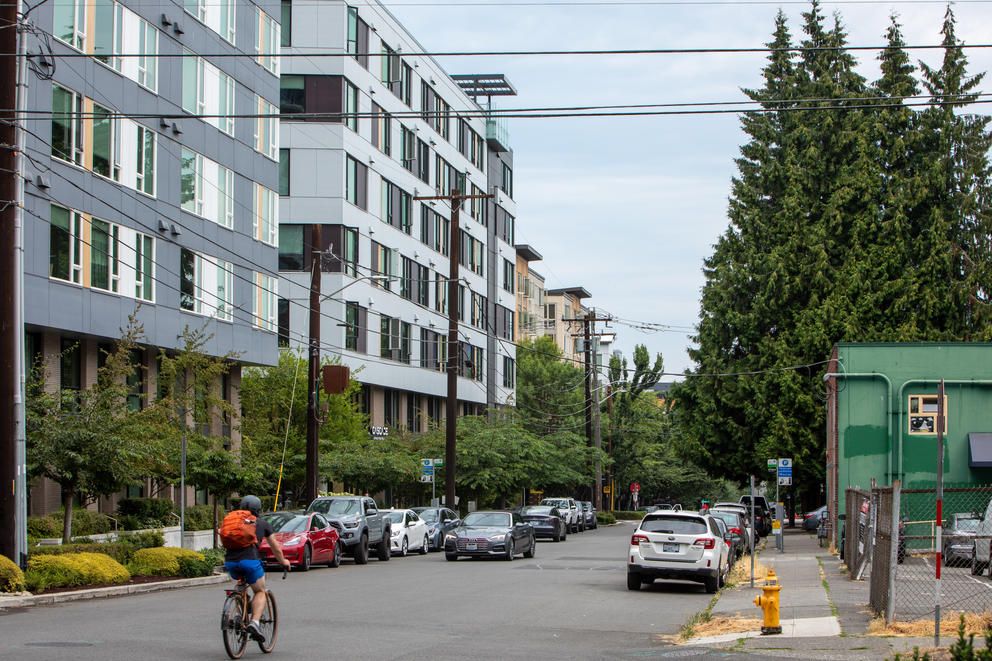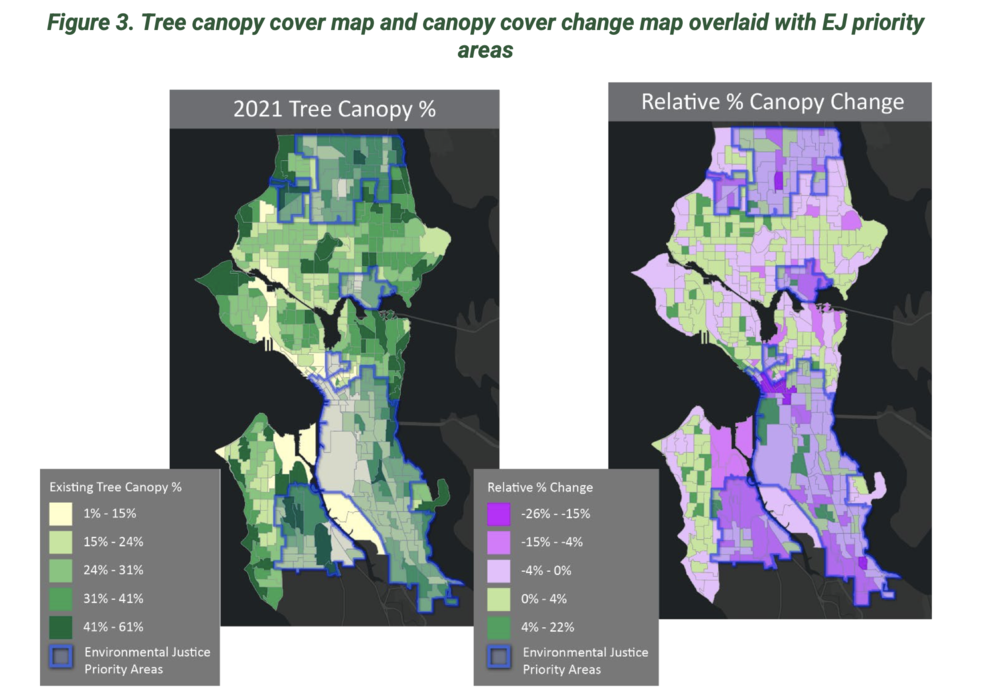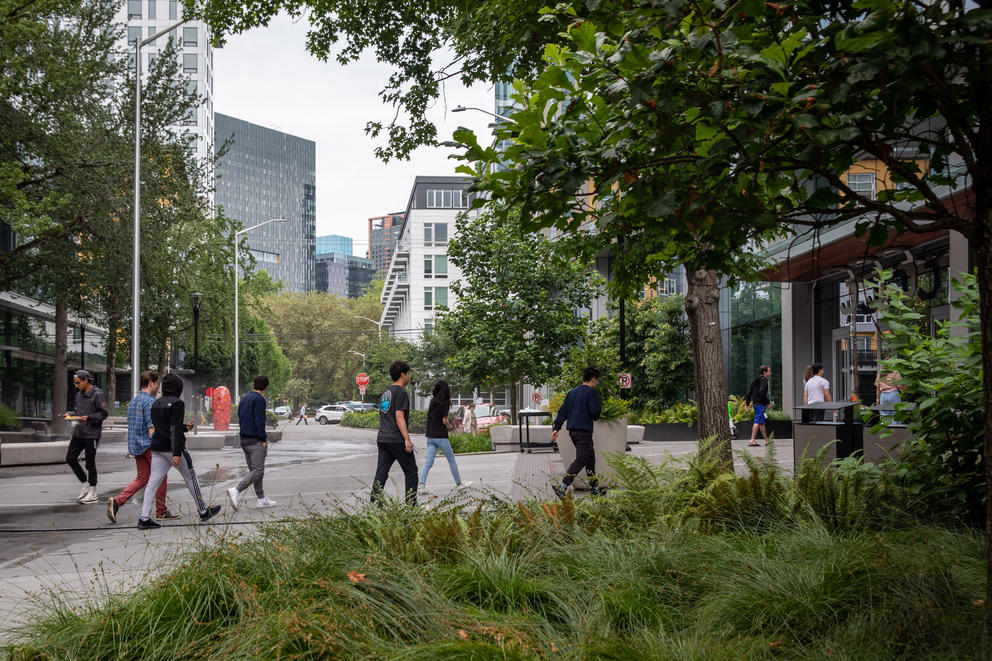Trees make cities and their residents healthier and more resilient in a warming world. From reducing stormwater runoff to capturing carbon and cooling the air beneath them, trees and their canopies offer environmental benefits while making neighborhoods more beautiful places for people and animals to live.
Not only did the city not expand trees rapidly enough between 2016 and 2021 to increase its canopy, it lost canopy in that time, especially in its least forested places, according to a report released this week.
“We are slowly losing ground … [and] canopy loss is not happening equitably,” the report authors write in a sobering section on the key findings from the study, published Feb. 28 and meant to inform future management strategies.
The assessment was produced by the city’s Office of Sustainability and Environment using information from the University of Vermont’s Spatial Analysis Lab. Researchers combined LiDAR remote sensing and satellite imagery to evaluate the city’s canopy, measured as “the layer of tree leaves, branches and stems that cover an area when viewed from above.” They analyzed the imagery to see where trees are and in what number and size, and discovered that the city area covered by tree canopy fell a net 255 acres — an area roughly the size of Green Lake.
There have been gains, as existing trees have grown and people have planted thousands of trees in recent years. But while the research found 1,534 newly recognizable acres of canopy, 1,790 acres were lost. That equals a .5% reduction in the amount of city land covered by canopy, from 28.6% coverage in 2016 to 28.1% in 2021, or a relative loss of 1.7% of the total canopy.
Data on the number and size of trees are not yet finalized, said Patti Bakker, OSE’s urban forestry adviser, via email. She also clarified that the assessment style does not determine a tree’s current health.
“Losing any amount of canopy cover can be disheartening … [but] we are optimistic that the data gleaned in this report … will help to create strategies that align Seattle’s development and tree preservation needs and include innovative and equity-driven actions in planning, maintenance, planting, and engagement,” Bakker said.
Urban tree-canopy assessments in Seattle have a spotty history. When the city adopted its 30% canopy coverage goal in 2007, city staff believed Seattle had 18% tree canopy. Other methodologies give different statistics, with such variety that — according to the organization Sightline — an alternative manual check of aerial imagery revealed the city had a 33% canopy at that time. But neither number equals the 40% canopy coverage Seattle is believed to have had in the mid-1970s.
Tree advocates in Seattle associated with TreePAC commend the city for continuing to assess its trees, but have concerns about how the assessment was done.
“It has done a nice job trying to evaluate the canopy and some of the implications, but I believe that it hides the severity of the impacts,” says Richard Ellison. Ellison says that the U.S. Army Corps of Engineers vegetation assessments have considered anything detectable at less than 20 feet above the ground to not be tree canopy; OSE says this study measures any canopy at or above eight feet. “Large shrubs and young saplings are being measured as part of the tree canopy. And if you cut down a large tree and then replace it with a shrub or a small tree, there's really a tremendous loss of volume and function of the canopy.”
Hannah Kett, urban program director with the Nature Conservancy in Washington, says the assessment rightly points out that we’re experiencing the impact of climate change, and that strategies need to include investing in planting trees that are adapted to future conditions.
The assessment does not note how much of the losses are larger, older trees.
With current development and green regulatory requirements, Ellison says, “I don't see how the city can possibly meet its goals of 30% tree canopy by 2037.”
The report’s authors suggest that hurdles to canopy growth include everything from climate change to invasive species to budget limitations. A warmer world means trees are more vulnerable to pests and drought, and need both more water to survive and more time to establish. About 63% of Seattle’s canopy is deciduous trees, many of them older and probably more susceptible to both drought and pests, the authors suggest. And in a rapidly growing city, trees sometimes lose out to development. Seattle added 58,000 residents and 47,000 housing units over the five-year assessment period.
“Losses occur quickly and can erase gains that took years to achieve. While planting new trees is critical … protecting and preserving existing mature trees contributes more in the near-term to overall canopy growth and associated co-benefits,” the assessment authors write. City staff believe conifers are more useful to ecosystems year-round, and have been working to “return Seattle’s forest closer to its native composition,” with a 9% increase in evergreen trees over the past five years.
“When [deciduous trees] are replaced, we prioritize conifer species where possible and appropriate,” Bakker says.
The assessment shows that places with the least tree canopy tend also to be places where people most impacted by racial and economic injustice live, in line with findings from the first tree-canopy assessment published using data from 2016.
The current study also shows these often tree-sparse places are losing their canopy more quickly than the citywide average. The least advantaged neighborhoods, and therefore the highest priority for city investment, had 31% less tree canopy than the most advantaged, compared to 27% less in 2016. Places like Rainier Valley, the West Duwamish Greenbelt, and Northgate suffered notable losses.
Dr. Jessica Hernandez, who represents environmental justice concerns on Seattle’s Urban Forestry Commission, says that these losses amplify other systems of inequality. “I would love to see more bottom-up approaches (that come from the communities directly impacted) amplified by the city. We shouldn’t forget also to center the Indigenous presence and past/present history, especially in a city named after an Indigenous leader,” Hernandez wrote in an email.
That disparity comes into stark focus during heatwaves, when trees can keep neighborhoods cooler, and the assessment authors quantified for the first time just how extensively trees can damp down temperatures. In evaluating 2020 temperature data, the researchers found that on the city’s warmest afternoons, areas with at least 26% canopy coverage were an entire degree cooler than areas with no canopy.
“A reason that lower-resource neighborhoods lose a larger percentage of their trees is that they don't have a lot of people with time on their hands … or resources to hire land-use attorneys to fight about a neighbor’s tree that’s threatened,” said Sandy Shettler, a board member of TreePAC. “They end up losing their trees kind of silently. … The impacts fall more heavily on people who can't fight back.”
The assessment also evaluated how different categories of land — natural areas, Downtown, developed parks, multifamily areas and more — compare in terms of canopy. The greatest amount of lost canopy happened on the specific types of land where many people live and recreate: one-third in single-family neighborhoods, which cover 39% of total city area. Park natural areas, where trees grow densely, suffered high proportional losses.
“The parks’ loss was a little bit of a heads-up,” Shettler says. “We're so focused on these losses to development, but we cannot forget that we're also dealing with [stresses like] new pathogens.”
The assessment authors offer nonbinding recommendations to help the city better meet its goals of more — and more equitable — canopy, something factoring into the Mayor’s touted upcoming One Seattle Tree Strategy. The recommendations range from better integrating climate change into strategies, realizing environmental-justice commitments, involving residents in tree care and prioritizing caring for existing trees, “since preserving existing tree canopy is the most effective way to ensure future tree canopy.”






